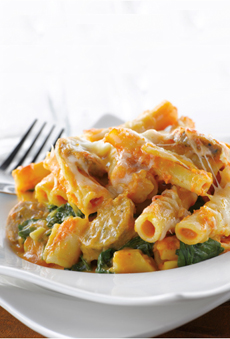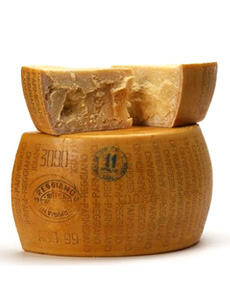|

Add pumpkin to your pasta. This delicious
baked ziti recipe uses sausage and spinach as
well. Photo courtesy Libby’s. |
|
Last year, America’s pumpkin growers produced almost 1.5 billion pounds of the colorful winter squash. Pumpkin production peaks in October, with the demand for jack o’lanterns and pumpkin pie.
Not to mention pumpkin brownies, pumpkin cake, pumpkin cheesecake, pumpkin cookies, pumpkin crème brulee, pumpkin crème caramel, pumpkin cupcakes, pumpkin fudge and chocolate truffles, pumpkin ice cream, pumpkin mousse, pumpkin pancakes, pumpkin pudding, pumpkin tarts and pumpkin waffles.
(Are you ready to start cooking? See our recipe resources below.)
But pumpkin flesh, also called pumpkin meat, can—and should—be used for more than desserts and sweet treats. See how many different savory pumpkin dishes you can put on the table this season.
“Pumpkin season” doesn’t end with Thanksgiving dinner, either. This nutritious* vegetable is available through the winter. And it’s only 49 calories per cup, steamed or boiled. (Keep the calories down and the cholesterol away by seasoning with salt, pepper and your favorite spices (from cinnamon to chipotle), and using olive oil instead of butter.)
|
SAVORY PUMPKIN RECIPES
Pumpkin can be baked, boiled, microwaved, roasted, steamed, stir-fried and stuffed.
Mashed pumpkin is as delicious as mashed sweet potatoes (try it with a Gruyère gratin).
Make pumpkin fritters.
Pumpkin purée can be mixed into bread and muffins, made into soup and dip, and used for savory soufflés (and sweet ones, too).
Pumpkin cubes can be added to chili, stew or a medley of roasted fall vegetables.
Roasted pumpkin can be added to salads—with or without pumpkin seeds.
Pumpkin goes international—from pumpkin curry to pumpkin tempura.
Pumpkin pairs beautifully with pasta: from everyday spaghetti and penne to lasagne and ravioli. Try the baked ziti with pumpkin, sausage and spinach in the photo above, add cooked cubed pumpkin to your pasta sauce, or purée pumpkin as sauce, seasoned with salt, pepper and your favorite spices (you can add an Italian grating cheese).
And don’t forget pumpkin pizza!
SOURCED FOR PUMPKIN RECIPES
PumpkinRecipes.org.
TheVeryBestBaking.com—far more than baking, lots of pumpkin recipes from Libbys.
Search through THE NIBBLE’s many pumpkin recipes.
See the different types of squash in our Squash Glossary.
________________
*Pumpkin is fat-free, cholesterol-free and an excellent source of vitamin A. The orange pigment is beta-carotene, a powerful antioxidant that converts to vitamin A in the body. A diet rich in beta-carotene may reduce the risk of developing certain types of cancer, and offers protection against heart disease and other diseases, including some degenerative aspects of aging. Pumpkins are also a good source of vitamin C, a second powerful antioxidant, and deliver calcium and dietary fiber.
|




